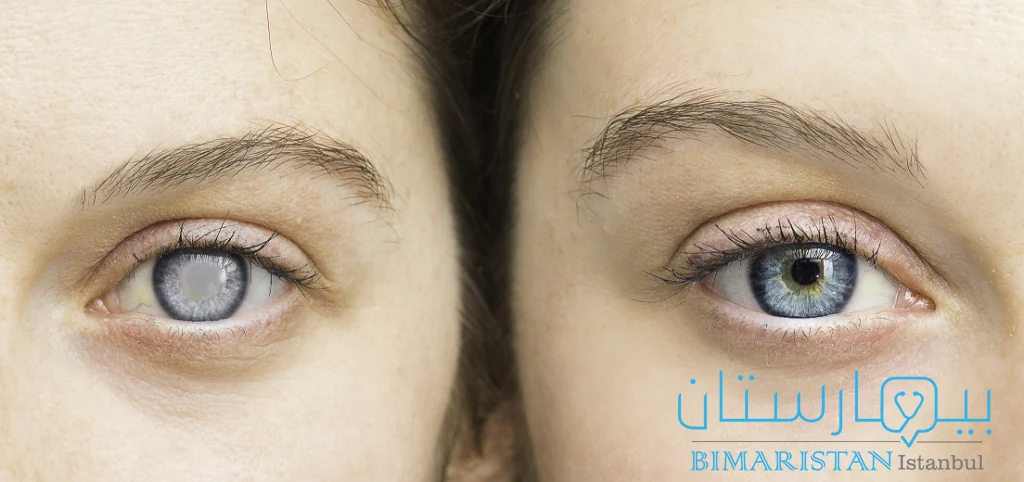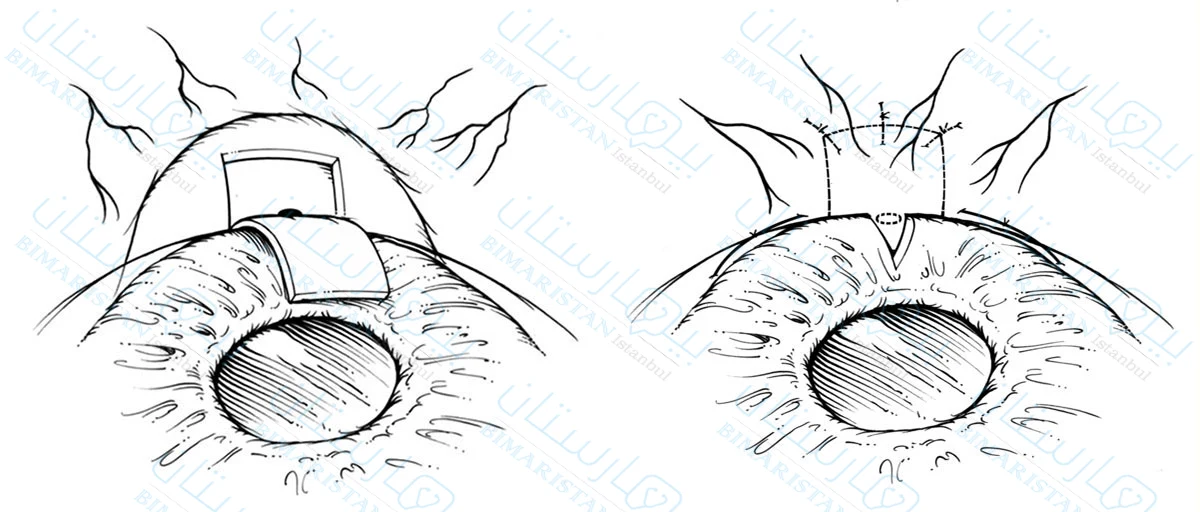تعد عملية علاج المياه الزرقاء في العين- الغلوكوما Glaucoma من العمليات الشائعة، وهي من أهم أمراض العين، لذلك تحتاج أفضل الأيادي وأمهرها من أطباء تركيا لإجراءها.
ما هي عملية علاج المياه الزرقاء في العين – الجلوكوما؟
عملية علاج المياه الزرقاء في العين أو الغلوكوما (glaucoma) من العمليات الشائعة التي تجرى يومياً، وتعد من أهم طرق علاج المياه الزرقاء في العين، وتحتاج إلى رعاية خاصة بالنسيج البصري الحساس لتحقيق أفضل نسبة نجاح لعملية المياه الزرقاء، والتقليل من تكلفة القيام بالعملية في أهم عيادات العين التخصصية لإجراء عملية المياه الزرقاء في تركيا.
لمحة عن مرض المياه الزرقاء في العين – الغلوكوما
إن العين في إنتاج دائم للخلط المائي (وهو سائل شفاف مائي يشبه البلازما يوفر التغذية لمكونات العين في قسمها الأمامي كما يحافظ على ضغط العين في هذا القسم ثابتاً)، وإن هذا الخلط المائي يحتاج إلى تصريف، وإن تصريفه يحدث عبر الجيب الوريدي الصلبي أو ما يدعى بقناة شليم Schlemm’s Canal.
تتوضع قناة شليم عند الوصل القرني الصلبي (فوق مكان اتصال القرنية بالصلبة)، وهي تصرف الخلط المائي وتحافظ على توازن الضغط في العين الأمامية.
وإن أي خلل أو نقص في تصريف هذا الخلط المائي (مهما كان السبب)، سيسبب ارتفاع في ضغط العين وسيؤثر ذلك على العصب البصري.
مرض المياه الزرقاء في العين أو الغلوكوما يسبب تأذي وتلف مزمن وتدريجي في العصب البصري (العصب البصري هو حزمة من الألياف العصبية التي تحمل الرسائل البصرية من الشبكية إلى الدماغ) قد يصل إلى العمى.
السبب الرئيسي للعمى بسبب الجلوكوما كما ذكرنا هو ارتفاع ضغط العين مما يسبب أذية العصب البصري قد لا تكون عكوسة.
يعاني حوالي 80 مليون شخص حول العالم من الجلوكوما وهي أشيع سبب للعمى عند كبار السن.
أنواع المياه الزرقاء في العين – الجلوكوما
يمكن أن نقسم الجلوكوما إلى قسمين رئيسين، الجلوكوما الأولية (في حال كان السبب مجهولاً)، والجلوكوما الثانوية (إذا كان السبب معروف).
الجلوكوما الأولية
وهو النوع الأكثر شيوعاً حيث أن أعلب الحالات تكون مجهولة السبب، ونذكر عدة تحت أنواع لهذا النوع:
الزرق المفتوح الزاوية
هذا هو النوع الأكثر شيوعاً من الجلوكوما الأولية والثانوية، ويحدث ذلك تدريجياً، حيث لا تصرف العين الخلط المائي كما ينبغي (مثل الصرف المسدود)، نتيجة لذلك، يتزايد ضغط العين ويبدأ في إتلاف العصب البصري. هذا النوع من الجلوكوما غير مؤلم ولا يسبب تغيرات في الرؤية في البداية.
وتأتي خطورته هنا، حيث لا يحس المريض بأي ألم في البداية، ولا يأتي للطبيب حتى يبدأ بصره بالتدني، ومن الممكن أن يأتي وقد فقد بصره تماماً.
الزرق المغلق الزاوية
إن الزرق مغلق الزاوية هو حالة إسعافية تحتاج إلى التدخل الطبي الإسعافي لإنقاذ العين وإنقاذ البصر.
حيث أنه في هذا النوع من الجلوكوما، تمنع الحافة الخارجية للقزحية (الجزء الملون من العين) تصريف السوائل (الخلط المائي) من مقدمة العين، فيتراكم السائل بسرعة، مما يؤدي إلى زيادة مفاجئة في ضغط العين.
إذا لم يتم علاجه، يمكن أن يسبب الزرق مغلق الزاوية العمى في غضون أيام قليلة.
الزرق الولادي
وهو يظهر عند الأطفال الحديثي الولادة، وهو مرض نادر لا يشاهد كثيراً.
عادةً ما يكون لدى هؤلاء الأطفال مشكلة في تصريف السائل في القسم الأمامي للعين.
الجلوكوما الثانوية
وهي تنتج عن أمراض أخرى سواء كانت عينية أم جهازية ونذكر من تحت أنواعها:
الزرق الوعائي
وهو ينتج عن تشكيل العين لأوعية دموية جديدة في مكان تصريف السوائل (قناة شليم).
وهي حالة غالباً ما تنشأ عن حالات طبية أخرى كارتفاع ضغط الدم أو السكري.
الزرق الصباغي
يحدث الجلوكوما الصبغي عندما تتساقط الصبغة (اللون) من قزحية العين (الجزء الملون من عينك) وتمنع هذه الجزيئات الصباغية من تصريف السوائل.
الرجال البيض الصغار الذين يعانون من قصر النظر هم أكثر عرضة للإصابة بالزرق الصبغي، وغالباَ ما يظهر لدى المصابين بهذا الزرق رؤية ضبابية أو يرون حلقات بلون قوس قزح حول الأضواء، خاصة عند ممارسة الرياضة.
الزرق العنبي

جراحة المياه الزرقاء في العين – الجلوكوما
جراحة المياه الزرقاء (الجلوكوما في العين) هي إجراء يهدف إلى تقليل ضغط العين في محاولة للمحافظة على العصب البصري واستقرار الرؤية ومنع فقدانها في المستقبل.
إذا لم تعالج القطرات العينية أو الأدوية الفموية الحالة بالشكل المطلوب، قد يوصي الطبيب بإجراء عملية المياه الزرقاء أو الجلوكوما.
الهدف من علاج المياه الزرقاء جراحياً هو إجراء فتحة جديدة لتصريف السائل من العين (أو عن طريق زرع تحويلة للمساعدة في تصريف السوائل)، علاج المياه الزرقاء جراحياً يمكن أن يخفض ضغط العين ويساعد على استقرار الرؤية لفترة طويلة جداً إلا أن المتابعة الدورية دائماً مطلوبة.
أحدث التقنيات لعلاج المياه البيضاء (الكتاركت) والزرقاء أصبحت متوفرة اليوم في تركيا، مما أسهم في تقليل المضاعفات بشكل ملحوظ.
متى تكون عملية علاج المياه الزرقاء في العين – الجلوكوما ضرورية؟
من الممكن السيطرة على معظم حالات المياه الزرقاء باستخدام القطرات والأدوية وعادة ما يستخدم دواء واحد أو أحياناً عدة أدوية، قد تكون الجراحة هي الأفضل والأكثر فعالية في حالات معينة.
يفشل العديد من المرضى المصابين بالمياه الزرقاء في استخدام القطرات العينية والمواظبة عليها وفقاً للتوجيهات، نتيجة لذلك تتزايد الحاجة إلى العلاج الجراحي.
أنواع عمليات علاج المياه الزرقاء في العين في تركيا
هنالك العديد من عمليات علاج المياه الزرقاء في العين (الجلوكوما)، أفضل وأشهر الأطباء في تركيا سيقومون بتقييم حالتك بشكل فردي ويساعدوك على تحديد الخيار الأفضل بالنسبة لك.
جراحة المياه الزرقاء طفيفة التوغل (minimally invasive glaucoma surgery (MIGS في تركيا
غالباً ما يفضل الأطباء عمليات المياه الزرقاء طفيفة التوغل على العمليات الجراحية الأخرى.
تتميز الجراحة طفيفة التوغل بآثار جانبية ومضاعفات أقل من جراحات المياه الزرقاء (الجلوكوما) الأخرى كرأب الترابيق (ومع ذلك في بعض الحالات يحتاج البعض لإجراء جراحات الغلوكوما التقليدية على الرغم من ارتفاع نسبة حدوث المضاعفات فيها).
تتطلب عملية المياه الزرقاء طفيفة التوغل إحداث شقوق صغيرة ومجهرية لزيادة تدفق الخلط المائي من العين، الشبكة الترابيقية هي شبكة من الأنسجة تقع في الغرفة الأمامية بين القرنية والقزحية والجسم الهدبي مسؤولة عن تصريف الخلط المائي من العين إلى الدورة الدموية، وفي حال انسداد هذه الشبكة يمكن أن يرتفع الضغط بالعين إلى مستويات خطيرة.
تهدف عملية المياه الزرقاء طفيفة التوغل خفض الضغط عن طريق إنشاء ممرات جديدة عبر الشبكة الترابيقية أو حولها باستخدام تحويلات صغيرة أو دعامات للسماح بتصريف الخلط المائي من العين بسهولة أكبر.
تشمل أنواع عمليات (MIGS) ما يلي:
- استئصال الترابيق الدقيق (عملية طفيفة التوغل).
- زرع دعامة صغيرة في الشبكة الترابيقية.
- بعض إجراءات الليزر.
باستئصال الترابيق الدقيق يتم إدخال أنابيب صغيرة الحجم في زاوية التصريف بهدف فتح القنوات المسدودة لتصريف الخلط المائي من الحجرة العينية الأمامية إلى أسفل الغشاء الخارجي الرقيق (الملتحمة) الذي يغطي بياض العين (الصلبة).
الأجهزة الحديثة تجعل عملية استئصال الترابيق الدقيقة أكثر أماناً.
تعتبر عملية المياه الزرقاء بالليزر المسماة الرأب الانتقائي للترابيق بالليزر خط العلاج الجراحي الأول للزرق مفتوح الزاوية، بواسطة أشعة الليزر نحدث ثقوب صغيرة تسمح لسوائل العين بالتصريف بشكل أفضل وتخفيف ضغط العين.

يمكن إجراء هذه العملية في عيادة طبيب العيون أو بمستشفى، وفقاً لآخر الدراسات يمكن لجراحة المياه الزرقاء (الجلوكوما) بالليزر أن تخفض ضغط العين بنسبة 20-30%، تبلغ نسبة نجاحها حوالي 80%.
قد لا تكون هذه النتائج دائمة ويمكن تكرار هذا العلاج بأمان في الكثير من الأحيان.
عمليات استئصال الترابيق لـ علاج المياه الزرقاء في العين
هي عملية المياه الزرقاء الأكثر أهمية، تسبب تخفيض ضغط العين بشكل كبير، في هذا الإجراء تتم ازالة قطعة من الشبكة الترابيقية لزيادة تدفق الخلط المائي.
يقوم الجراح بقص جزء من الملتحمة الذي يغطي الصلبة بالقرب من التقاء القرنية والصلبة ويصنع سديلة من الصلبة وبعدها يقوم التخصصي بطي هذه السديلة إلى الخلف ويتم إزالة قطعة صغيرة من الشبكة الترابيقية والقزحية لصنع مصرف أو دسام valve في الغرفة الأمامية للعين، بعد ذلك تعاد هذه السديلة إلى الخلف لخياطتها في مكانها بخيوط نايلون دقيقة مما يسمح بتصريف الخلط المائي إلى تحت الملتحمة.
تتم خياطة الملتحمة مرة ثانية في مكانها لتغطية المنطقة وامتصاص الخلط المائي المندفع بعد إستئصال الترابيق، تتشكل فقاعة صغيرة أسفل الملتحمة حيث تم تصنيع هذا الصمام.من خلال تعديل خيوط إستئصال الترابيق يمكن للجراح التحكم قي سرعة تصريف المياه وضبط الضغط داخل العين بالشكل المطلوب.
تجرى عملية إستئصال الترابيق على الجزء العلوي من العين تحت الجفن العلوي لذا فإن هذه الفقاعة والشقوق غير مرئية للمريض أو للأخرين.

قطع واستئصال القزحية
تجرى هذه العملية لعلاج الزرق مغلق الزاوية، يستخدم جراح العيون الليزر لإنشاء ثقوب صغيرة في محيط القزحية للسماح بتصريف المياه من خلالها يسمى هذا الإجراء ببضع القزحية.
تستخدم هذه الإجراءات لتقليل خطر تطور الجلوكوما مغلق الزاويه إلى هجمة زرق حادة وهي حالة مؤلمة يزداد فيها ضغط العين بشكل سريع وتعتبر حالة إسعافية تتطلب تدخل سريع لمنع الوصول للعمى أو فقدان الابصار.
وبشكل عام ارتفعت نسبة نجاح عملية المياه الزرقاء في تركيا، ووفقاً لآخر الدراسات، معدل نجاح عمليات الزرق من 80% وتصل ل 100% تقريبًا حسب العملية المجراة.
مضاعفات عملية المياه الزرقاء
مثل أي عملية أخرى، فإن عملية المياه الزرقاء تحمل درجة من المخاطر.
إجراء العملية في مستشفى تخصصي لطب العيون مزود بأحدث التقنيات وبإشراف أهم الأطباء يساعد في منع هذه المضاعفات، التي يمكن أن تشمل:
- الشعور باحمرار وألم في العين.
- تهيج في القرنية.
- بقاء ضغط العين مرتفع.
- انخفاض ضغط العين.
- أعراض الالتهاب أو العدوى.
- ارتفاع خطر الإصابة بالمياه البيضاء (إعتام العدسة).
- في حالات نادرة، فقدان البصر في مستويات مختلفة.
اتصل بنا في حال واجهتك أي مشكلة أو لديك أعراض تشبه أعراض الإصابة بالمياه الزرقاء في العين – الجلوكوما، وإن أخصائي مركز بيمارستان سيجيبون عن أي استفسار لديك.
التعافي بعد عملية المياه الزرقاء وما يجب تجنبه
تختلف الفترة المطلوبة للتعافي حسب نوع العلاج فقد تتراوح من عدة أيام إلى أسبوعين أو ثلاث، يكون التعافي سريعاً في الإجراءات طفيفة التوغل وتحتاج معظم الجراحات عدة ايام للتشافي.
بعد عملية المياه الزرقاء يكون الضغط في العين منخفض، نتيجة لذلك يوصي الدكتور بتجنب الانحناء الشديد خلال الأسبوع الأول.
كما أنه يمكن لمعظم الأشخاص استئناف الأنشطة اليومية مثل القراءة ومشاهدة التلفاز أو استخدام الهواتف المحمولة أو الكمبيوتر في غضون الأيام القليلة الأولى بعد عمليه المياه الزرقاء.
بعد عمليّة المياه الزرقاء (الجلوكوما) يمكن الاستحمام مبكراً بشرط استخدام حماية للعيون (درع أو نظارات) لمنع الاهتزاز أو فرك العيون.
بعد علاج المياه الزرقاء جراحياً ينصحك دكتور العيون بالابتعاد عن الأنشطة التالية خلال أسبوعين كالجري أو رفع الأثقال، يجب تجنب أيّة أنشطة قد تصيب العيون بعدوى أو التهاب كالسباحة أو استخدام أحواض المياه الساخنة، العدسات اللاصقة القابلة لإعادة الاستخدام، وضع مكياج حول العين أو كريم الوجه.
